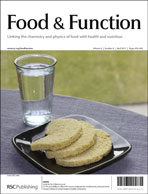In vivo antioxidant activity of carotenoid powder from tomato byproduct and its use as a source of carotenoids for egg-laying hens
Abstract
Ultrasound treatment was used to extract carotenoids from tomato waste. Gelatin and gum arabic were applied as coating materials for the encapsulation of carotenoids. The first-order reaction was used to determine the degradation of carotenoids in the microcapsules. The result of controlled release studies showed that microcapsules would protect most of the carotenoids from being released in the stomach. We investigated the modifications induced by an oral administration of carotenoid powder on lipid peroxidation, antioxidant enzymes and ion status in liver of rat. The 28 day treatment increased the activity of glutathione peroxidase and manganese superoxide dismutase and reduced malondialdehyde concentration in rat liver. The activity of catalase was not affected by treatment and greater iron concentration was found in liver from treatment groups. However, there was no dose-dependent change of antioxidant enzyme activity or malondialdehyde concentration with increasing carotenoid consumption. Furthermore, carotenoid powder was able to be used as forage material for egg-laying hens. The 28 day treatment did not affect the egg performance, but significantly increased yolk colour parameters and lycopene content.


 Please wait while we load your content...
Please wait while we load your content...